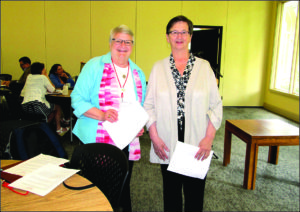
TODAY’S CATHOLIC

SAN ANTONIO • A variety of breakout sessions educated directors of religious education, catechists and teachers on the Called and Consecrated: Exploring the Lives of Women Religious curriculum at the National Catholic Sisters Project’s (NCSP) professional development and continuing formation workshop in June.
Giving an overview of this curriculum which explores the lives of women religious were Sister Andrea Lee, IHM, president of Alverno College and national leader of the National Catholic Sisters Report, and Sister Ann Oestreich, IHM, national coordinator for the National Catholic Sisters Project and social justice coordinator for her congregation.
“Our mission in this project is to try to create greater visibility for the work and the ministry and the lives of women religious,” said Sister Andrea, “thereby creating interest among young women who are in their years of vocational choice.”
Her involvement in the project began in 2013 when, as president of St. Catherine University in St. Paul, Minn., she received a call from the project director of the arm of the Conrad N. Hilton Foundation dealing with Catholic women religious, giving her the opportunity to write a $3 million grant. Awarded the grant, Sister Andrea became de facto project head and it kicked off with establishing National Catholic Sisters Week in March, coinciding with National Women’s History Month.
They also initiated doing oral histories of women religious across the country, particularly in congregations with older women religious, now in their 80s and 90s, who had been vital forces in the evolution of religious life. University students were paired with sisters all over the country to hear about their work and why they chose religious life. Additionally, an event featuring conversations, liturgies and a film festival was held to which sisters and young women representing 50 colleges were invited. “We created lots of energy,” recalled Sister Andrea.
When she moved to Alverno College in 2016, the project moved with her and phase two of the grant brought geographical diversification, along with major outreach to Latina young women, Vocaciones Hispanas, and introduction of the Called and Consecrated curriculum project, housed at the University of the Incarnate Word. A component of this is partnering with dioceses who particularly care about women religious and have large Hispanic populations. So far, this includes the dioceses of Atlanta, Boston, Chicago, Baltimore, Des Moines, Milwaukee, Newark, San Antonio and St. Paul and Minneapolis.
National Catholic Sisters Week moves into its sixth year in 2019, noted Sister Ann, with the number of events continuing to grow. This past year saw 400 events taking place nation-wide, both in person and the increasingly popular online. “Check our website in September,” she added, “because if you’d like to post a National Catholic Sisters Week event, and you need a little financial help, we offer mini grants.”
Vocaciones Hispanas she related, is staffed by Sister Marichui Bringas, CCVI, who is designing online resources for discerners and for vocation directors in Spanish and is available to travel throughout the United States to work with dioceses, Catholic schools departments, vocation or consecrated life departments and others. “We would be more than happy to send her on behalf of the project, to work in your diocese with you,” she said.
The Called and Consecrated curriculum is designed for grades six through 12, she noted, and is easily adaptable for campus ministry. Three units were already posted online at www.nationalcatholicsistersproject.org, with a fourth, Service, going up that week, and future units to include Charisms, History of Religious Life and Prophetic Voice.
“This team here at UIW has a particularly deep commitment to provide support for educators, for teachers,” she said, with pre- and post-lesson notes available online. Support of vocational outreach in partner dioceses includes sharing curriculum materials with them and offering financial support to provide programs for sisters and for interested women to extend their own vocational outreach within their dioceses.
The website also includes a Sister Story blog, filled with stories written by college students and others telling of their experiences relating to sisters. “If you’d like to write for us, we’d love to have you,” said Sister Ann. “There’s a place where you can thank a nun — somebody who has been influential in your life,” Sister Story also includes Curve Riders, consisting of stories of sisters who made a “sea change” in society or the church.
Explaining integrating the curriculum into one’s classes were department religion chair and teacher Christopher Samuel, Ph.D., and campus minister Rosi Cortez from St. Anthony High School. Cortez related the pilot program began with a call from Sister Walter Maher, CCVI, vice president for mission and history at UIW. “We need to make the sisters visible,” she told Cortez, who noted, “This curriculum does that. It makes them profoundly real.”
“We were very lucky to get to test-drive this program with some of my students,” said Samuel. Two of his classes visited a UIW computer lab to explore the curriculum online and their reaction was overwhelmingly positive. The curriculum links to other resources and organizes everything conceptually, he observed, making use of things like podcasts and videos. “They loved the different kinds of media that they get a chance to access in order to get them to know sisters and sisterhood better,” he reported. What they were most interested in, he discovered, was getting to know sisters on a more personal, relational level. They wanted to know what they did in their free time and what their life was like before becoming a sister.
St. Anthony has been very lucky, noted Cortez, because they have a CCVI sister who visits the school once a week. The sister insisted on getting to know the students on a personal level by eating her lunch at a table in the cafeteria and letting them come to her — and they came. She told them about her life before becoming a sister, that she went to parties, had a crush on a boy and did things that got her parents upset. She became real to them because her story sounded like their own.
“Our goal today is not to tell you what to teach,” said Samuel. “It’s just to give you some ideas, some examples in my kids, of where to insert the curriculum into what you are all already doing.” He related introducing the vocation unit to his sophomores when they studied salvation history, with its coming of Jesus and the implications of what he did for us being a perfect tie-in for discussing vocation as a response to God’s call, but “not with a capital V.” Anybody’s life can be a vocation, and things like marriage or being a doctor are also callings, he noted. “We want to help them make the connection that those are certainly callings and those are great, but this is one too.”
The salvation unit, with a section on prayer, can touch on aspects of the life of a sister by having the students pray the lectio divina or having a sister come and teach them how to pray. Discussing church hierarchy in his ecclesiology class was the ideal place to bring up sisters as a component of co-essentiality in church hierarchy or organization.
Sisters and their role in social justice are very important at St. Anthony’s, said Cortez, with students working closely with two CCVI-involved ministries. After school, they tutor children at Visitation House, a transitional living home for single mothers and their children, which is directed by Sister Yolanda Tarango, CCVI. Seeing a video on Sister Yolanda talking about her life showed them a new dimension of her as someone who fights for immigration rights and women’s rights. “She became somebody that was not just the sister in charge of this program,” Cortez related, “but this person fighting for justice everywhere.” It was a huge “aha” moment.
The students also assist CCVIs ministering to the homeless under the bridge and those being deported at the bus station. “They begin to see them as these ‘soldiers for justice,’” she said.
Lastly, said Samuels, when talking about the saints or holiness, teachers can point to the sisters, who are on a journey to holiness. “We can give our students an example of what a journey to holiness might look like,” he said, as well as what their own journey to holiness could look like.
QuickInfo
Visit: www.nationalcatholicsistersproject.org. Contact the National Catholic Sisters Project at: 3400 South 43rd Street, Milwaukee, WI 53234; 414-382-6061; or contact@nationalcatholicsistersproject.org.


